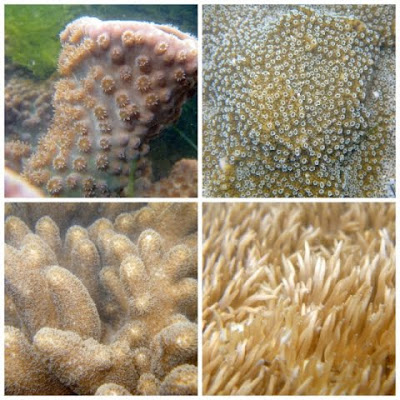On Saturday, I was out at Tanjong Rimau, Sentosa with NIE friends to look at the area for our field trip project. It was their first time on our shores so I was excited to share our marine habitats with them.
The soft coral can get quite big and here is a group photo of Dominique, Janet and Xinyi with the coral.
Whereas Wan Ting and Yan Ping were adventurous and headed to check out the beacon. I did not realize how big the beacon was until they stood beside as scale!
That day's tide was really low, much lower than expected. And all sorts of colourful marine life were revealed!
The different types of sponges include the brightly coloured Smooth blue sponge (Lendenfeldia cf. chondrodes) and the Yellow prickly branching sponge (Pseudoceratina purpurea).
At the background of an olive green Yellow prickly branching sponge (Pseudoceratina purpurea) is Yan Ping and the forts of Fort Siloso.

There are many hard corals of different sorts and these are the boulder corals of mainly Favid hard corals (Family Faviidae) and Pore corals (Porites sp.).
Also encountered on the shore is the Crinkled sandpaper coral (Psammocora sp.). It is not exactly boulder-shaped though.
What a pleasant surprise to find the Tongue mushroom hard coral (Herpolitha sp.) at Sentosa. This coral is free living and not attached to the substrate as an adult.
Here's another one! This coral is considered to be a colonial animal with many mouths. Numerous mouths are found in the central groove and mouths may also be found elsewhere on the upper surface.
I think the kind of hard coral I like best at Sentosa is definitely their disk corals. This Thin disk coral (Turbinaria sp.) really looks like a rounded flat disk. It is relatively big, of about 20cm in width. Some parts of the edges are nicely bordered in purple.
The colony of Thin disk coral that I like best must be this ruffled version. It's been a long time I've seen such a colony on the shores. I'm glad that the seaweed bloom at Sentosa is not as bad as our other Southern shores at this point of time, so that I can still have a good look at the corals.
One of the mysteries I've seen on a couple of hard coral is the pink dots on the colony surface. Is it a response to some kind of stress?

I took my underwater camera for a swim and got some interesting perspectives of both hard and soft corals in the water.

In addition to hard corals, there are many Leathery soft corals (Family Alcyoniidae) of different types on the reef.
I think it was my first time seeing corallimorph at Sentosa and this is the Ridged corallimorph.
Each polyp of this corallimorph can be quite big, of about 4-5cm in width. They look graceful when in the water. Their mouth is found in the centre of each polyp.
A prettier corallimorph will be this brightly green-coloured Beaded corallimorph. They have round bead-like bumps on their polyps.
Different from sea anemones, corallimorphs are distinguished by an upturned central mouth.
Talking about sea anemones, I managed to get a nice decent photograph of this pretty Smooth frilly sea anemone (Phymanthus sp.). Their tentacles are generally smooth with a few slight bumps where 'branches' might be in other frillier frilly sea anemones.
Nudibranchs are always a delight to sight on the reef. I found this Pimply phyllid nudibranch (Phyllidiella pustulosa) on the underside of a rock.
Oh yes, I also saw a rare snail on another rock's underside, last seen since 1970s. Read more about it here!

More slugs seen among the bloom of Hairy green seaweed (Bryopsis sp.) include a tiny Polka-dot nudibranch (Jorunna funebris) and also a Dermatobranchus nudibranch (Dermatobranchus sp.). According to slug expert Bill Rudman, some Dermatobranchus species eat soft corals and sea fans.
After my many trips to Sentosa, I've named the crabs as the fantastic four. These are the four species that are commonly seen on Rimau. The first one is the Mosaic reef crab (Lophozozymus pictor), the most poisonous crab in Singapore.
The second is the Red egg crab (Atergatis integerrimus) which is also an inedible species.
The third is the also-inedible Brown egg crab (Atergatis floridus).
While finally the fourth is the Swimming crab (Thalamita sp.). Interestingly, the swimming crab is the only edible crab among the fantastic four but the ones on this shore are usually too small for consumption.
The team was excited when they saw a big octopus on the rocky shore. By the time I went to check it out, the octopus has already been halfway hidden among the rocks.
I found this juvenile Copperband butterflyfish (Chelmon rostratus) on the tidal pool and it is a very brightly coloured and pretty fish. This individual was very active.
Last but not least, two of these Orange-edged black flatworms (Pseudobiceros uniarborensis) were found! It seems that this species is in season now that we see them in different shores at the same time.
As mentioned earlier, the tide was surprisingly lower than expected and a wide expanse of the reef was exposed.
We were accompanied with a spectacular sunset with Bukom refineries at the background. Thank God for the good weather!
On the way back, I checked out the lovely Land hermit crabs (Coenobita sp.) that I saw on the previous trip.
In overall, the trip was much better than I expected, thanks to the good low tide! :)
Monday, January 4, 2010
Sentosa with NIE friends
Subscribe to:
Post Comments (Atom)





























.jpg)

No comments:
Post a Comment